Deepak G. Pawar's Blog, page 12
September 24, 2016
Book review: Ghachar Ghochar
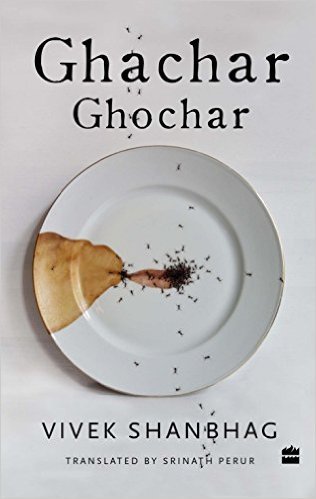
Ghachar Ghochar
Vivek Shanbhag
Translated by Srinath Perur
Harper Perennial 2016
This is more like an extended short story of the rise from lower to upper middle class status of a Kannadiga family comprising father, mother, daughter, son and uncle.
The complexities in relationships, the petty quibbles, the familiar trappings of having to make ends meet as a lower middle class family, and the sudden wantonness that creeps into the family as its status rises, have been charmingly related in original Kannada by Shanbhag, and in translation by Perur.
The seemingly trivial misdeeds of the family take on a sinister turn towards the end, when its comfortable if somewhat disarrayed existence is shaken by the new arrival: the son's wife.
The son, who happens to be the narrator of the story, finds solace from the bickering women of his household by visiting a local cafe, where he is counselled in passing by the omniscient waiter.
There are two leitmotifs in the narrative: the ants in the old house which turn up each time there is a crumb to be carried away; and the beverage tea, which the family members adore consuming, and also helps them bond with each other.
The description of the old family house, and the problem with the ants have been described with a vivid detail, which strikes a chord with one who is familiar with the travails of lower middle class existence.
The meaning of the enigmatic title - not a Kannada phrase - is unraveled by the son's wife, who one cannot help sympathizing with as she has to take on, and face the wrath of the family that she is married into.
All in all, an engaging read.
Image source: http://ecx.images-amazon.com/images/I...
Published on September 24, 2016 07:39
September 17, 2016
Book review: Being Mortal
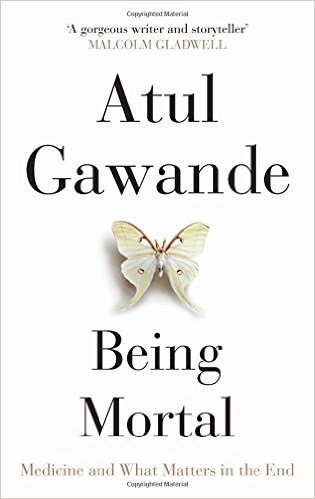
Being Mortal: Medicine and What Matters in the End
Atul Gawande
Penguin Books India 2015
As a medical professional, I have had people recommending this book to me on several occasions. Finally, after finishing this, I have realised why.
This book offers an alternative view to our traditional understanding of the role of medicine, which we take to be to fighting death and saving lives. In fact, we are told to 'preserve life' and to 'do not harm', which are part of the Hippocratic Oath that each one of us swears by as we graduate.
We have an added dilemma in the Indian context, since allopathic practice is largely a western construct, based on opinions, research and writings of westerns scholars, researchers and physicians.
The ancient medical and surgical practices propounded by the likes of Charaka and Sushruta, as well as the entire system of Ayurvedic have either been relegated to the sidelines, or grouped under rather patronising categories called 'alternative therapies' and/or 'complementary therapies'.
However, as we see in this book, ageing, the process of dying and death itself are the same wherever you practice in the world, or whatever system of medicine you adhere to. And the recommendations made by Gawande through this book carry universal relevance.
Gawande's book combines real life anecdotes, views of pioneers in end-of-life care, findings from research studies, and his own insights into these prickly issues that are often brushed under the carpet. As he convincingly argues, the often oppressive therapies that are inflicted upon the patient - such as radiotherapy, chemotherapy and surgeries with little benefit in cancer treatment - only end up prolonging the agony for the patient and his/her carer. Medical practitioners are often hesitant to talk about death and dying, in the face of misplaced expectations of miracle cures by patients and their carers.
Gawande draws from his own experiences as a surgeon, talks to patients with dementia and cancer, their families, and experts in the field of palliative care. He also puts himself on the other side of the fence, and includes a touching account of his own father's battle with cancer and eventual death. In so doing, he leaves us with pearls of wisdom on communicating with patients and their carers about death and dying.
He says, for instance, that a collaborative approach wherein the physician and the patient talk together about the choice of treatment available based on what actually matters to the patient in terms of his/her fears and hopes about the quality of life, is the best way forward in end-of-life care.
One has to take in all the stories and Gawande's interpretations if one is to find more such medical gems from this book. This makes it recommended reading for geriatricians, palliative care specialists, and indeed, every medical practitioner.
Gawande points out that the real victory for end-of-life care would come about only when every physician and surgeon incorporates these principles into his/her own practice, thus obviating the need for a separate specialty of palliative care.
Hardly surprising then, that Being Mortal was given as a parting gift to each of the graduating medical students recently, at the international medical school where I teach.
Image source: http://ecx.images-amazon.com/images/I...
Published on September 17, 2016 07:07
August 20, 2016
The Olympics: an alternative take
The quadrennial sporting jamboree is upon us and has the nation riveted; more due to raised expectations and missed opportunities than any real reason to celebrate.
Since the Rio Games began, we have come to realize, as ever, that it is going to be another disastrous outing for India at the Games. There have been several jokes and memes on the dismal performance of our athletes in yet another world event.
One of our dear socialites has once again found her foot in her mouth, as she so often does.
And another cross-border scribe has felt the collective fury of a nation's sports enthusiasts at his typically cretinous comment. (By the way, has anyone observed; these guys are more obsessed with India and its affairs then their own country).
In the coming weeks, articles will be written in the dailies and periodicals lamenting the missed opportunities; TV news anchors will cry hoarse demanding answers from indifferent sports representatives about the disaster, which you will be told, the 'the nation wants to know' about.
Public memory being short, and even as one breaking news knocks another off the pedestal, this brouhaha, much to the delight of the sports ministry, will be forgotten. For the next four years.
In the meantime, USA is at the top of the medals tally - no surprises there. As are a few other western countries. China is the sole Asian representative in the top-5 list. And we have somehow managed the 64th position (at the time of writing this); we may still go lower.
However, the good news is that over the last few days, we have witnessed three girls doing the country proud, culminating in the badminton silver which has the nation in a collective frenzy.
Sorry, I never watched the entire event, or any of these three games.
Whatever these three girls have achieved, is a huge bonus. Because I wasn't expecting any medals.
Now before you troll away, let me explain.

What are the Olympics? An 8th Century BC Greek phenomenon that was revived towards the end of the 19th Century in the West.
The West - that's the key word here. The West formed the rules for the western events, and the West included the games and sports invented in the western countries.
Take a look at the events in the Summer Olympics. Barring a handful, none of the events have originated in Asia, let alone India.
Basketball was invented in the US, and badminton derives its name from the Duke of Beaufort's house in England.
Even hockey has its origins in Eurasian countries other than India. And less said about golf as a sporting event, the better.

Or why not consider the Winter Olympics for a moment? Bobsleigh, curling, luge and Nordic Combined. Yeah, I haven't heard of any of these sports either. Probably conjured up by some bored westerner when he or she had nothing better to do.
The point that I am trying to make is this: we are participating in their Games, which include events made up by them, and governed by them. Naturally, we are competing against giants of the games; against athletes who have been training for these events for much longer and harder than ours, and in far better facilities. It will be a long time before we can catch up with these athletes.
The one game that India excels in - cricket - is not an Olympic event. And you can pretty much forget about kabaddi ever making it as an Olympic sport. Contrast this with something called whitewater slalom, which originated in Europe and made its Olympics debut in 1972, and you will see what I mean.
So if our athletes win medals, that's great; but if they do not, I understand.
But does this mean that we should be cry-babies? Should this be our excuse for our underwhelming performance in the Olympics?
Do we just lament the fact that our games have been left out and we have been cold-shouldered by others?
Hardly.
What had to be said had to be said - about the western hegemony of sporting events.
Now what has to be done has to be done - by us and our policy makers to uplift the status of sports in the country.
Actually, it had to be done a long while back, but better late than never.
But the question is, can it be done?
Because you see, sports are recreational activities. This means that one becomes inclined to undertake a sporting activity after he or she has been fed well, educated, and has a steady income.
Westerners can conjure up games creatively because of just that; they really have nothing better to do. They have finished establishing their roads, economy, educational and health institutions and benefits schemes. Therefore it is easy for them to go out trekking, cross country running and quad biking. It is possible for them to make sports a part of their culture that they and their children can actively participate in.
But in a country such as ours, where even today, the divide between rich and poor is so vast, sports can only be a luxurious undertaking for many. You cannot expect the hand that is busy trying to make ends meet to hold a tennis racket or volleyball.
Every successive government - including the present one - has done precious little to improve sports infrastructure in the country. The recent edition of The Week reports that the budget allocation for sports has been repeatedly cut down by every government that has come to power.
Probably understandable at one level. There are other priority areas that need attention: health, education and poverty alleviation, for example.
The Week issue also includes write-ups from sporting legends of India about the disastrous outing in the Rio Olympics, and what is to be done to redress this. Among other things, every sportsperson has touched upon one significant issue: that people from sports background should govern the sporting bodies in the country.
One cannot see this happening in a hurry, considering the fact that as recently as 2008, an ex-policeman held on to post and dear life as the president of the hockey federation, even as allegations of corruption mounted against him.
And what can one say about our organization of the Delhi Commonwealth Games, when the chief minister of the state and the incompetent politicians handling the affairs blamed everything from difference in hygiene standards between us and the West to Indradev for the abysmal preparations.
They blamed everything and everybody, that is, except themselves.
Leave the politicians and government aside for a moment.
What about ourselves?
Go to any mall on any day. You will find hundreds of students who are there with their shoulder bag of books, having bunked the classes for a good time out and to catch the latest film in the multiplex - all expenses provided for by their doting parents. This number jumps to several thousands over the weekends, when they come with their boy/girlfriends, and on some odd occasions, with their parents. The proportion of youngsters who utilize the same time to train in sports is tiny. Because sport is backbreaking hard work, and demands years of discipline and dedication. There simply isn't time or inclination for this kind of commitment in our lives.
Sports are not a priority even among the well to do. How many select sports as a career option? Is it not common for us to admonish our children for playing too long, when there is homework waiting to be finished, or the upcoming exam to be prepared for?
A recent WhatsApp forward summarized our attitude towards sports rather well: Who are we? Indians. What do we want? Olympic medals. What do we want our children to be? Doctors and engineers!
In fact the only reason some parents allow their children to pursue sports on the side is because there is a sports quota allocated for college admissions and jobs. Sport is not a career option, and the government has not done anything to make it one. Even the ones who somehow managed to achieve something in their chosen sport have been reduced to penury.
Bookish knowledge, school, college, exams, jobs, marriage, children, grandchildren, festivals, TV serials, films, elections, superstars and their tantrums, social media: these are our priorities; not sports.
To put it bluntly, we simply do not have a sporting culture.
So there you have it. This is the reason for my equanimity in the face of the Rio fiasco. This is why I said that I wasn't expecting any medals.
Having said that, let us take a moment to remind ourselves of what these three girls have managed to achieve. In winning these medals, they have beaten all odds; government apathy, lack of sporting culture, and most importantly in our country, gender bias.


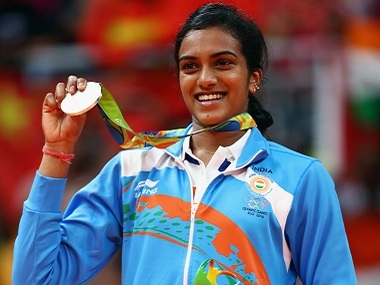
So thank you girls for giving us our quadrennial bonus.
We can rest easy for the next four years.
Image sources:
http://i1123.photobucket.com/albums/l...
Published on August 20, 2016 06:37
July 30, 2016
Visit to Ranathambore National Park
The air was nippy with the crisp December air. We were put up at the Ranathambore Regency Hotel where a bonfire was lit to warm the air, and Rajasthani folk dance was arranged to entertain the hotel's largely foreign clientele.
There is only one thing that everyone wants to do when they visit this place: go on the safari. Forget about visiting the local fort or the Raj Bagh ruins. The large government canters - open-air trucks with seats - arrived at each of the hotels lining the Ranathambore Road promptly in the morning to take us on our pre-booked safari.

And while on the safari, there is only one animal that everyone longs to see: the tiger.
You are reminded about being in the tiger's dominion in the hotel itself where you are greeted with pictures of the superstar in various poses and moods, lining all the walls of the lobby and corridors.
We were all bundled into a canter, which the hotel staff had cleverly set apart for their Indian guests. The foreigners hung around, waiting for their own canters to arrive: a neat little arrangement of segregation borne out of years of experience, perhaps.
True to its Indian nature, our canter ran into some starting troubles when it stopped in one too many hotels along the way to the forest. Soon, it was filled to the rafters - in a manner of speaking, as it was roofless! - and the last two tourists were left without a seat. The prospect of going on a jungle safari while standing in the canter was a bit too daunting, and they all ended up having a right royal argument.
The couple was insisting on having seats, the conductor was begging those with kids to put them on their laps, and those with kids were refusing to do so as they had paid for the kids' seats too!
Finally, after a few magnanimous seat adjustments, we were on the way. There was no time to lose; we rode away at a...well...canter!
To make up for the unsavoury starting trouble, the conductor, after some coaxing, agreed to take us to the zone where a tiger was last spotted. This had everyone perked up. Especially one of the tourists who said he had been all the way to Corbett National Park and came back disappointed as he did not see the one thing he had gone there to see: the tiger.
We hung onto our mufflers, sweaters, cameras, railings and each other, as the canter rattled along the path, deeper into the jungle.

We came across a big lake; the watering hole where the great animals of the jungle had congregated to quench their thirst and just hang about. Nilgais and sambars grazed about with a decoration of weeds on their antlers, while open-mouthed crocodiles lazed about in the still waters.


After a few pictures, we moved on...
Suddenly an air of expectation! Many canters and jeeps had assembled at the same spot near another lake. Heads were cocked and cameras turned in one single direction. We nearly fell over each other trying to catch a glimpse of whatever it was that had their rapt attention. And there it was! A single gigantic tiger, having its afternoon siesta in the grass, after a royal repast.
There is something wildly exciting about spotting a magnificent beast in its natural habitat, unchained and free. There was no difference between children and their adults at that moment, as everyone was so excited at having fulfilled their life's one pending wish: to spot a tiger in the wild. And they were so close to it! The conductor had a tough time trying to hush them up. After all, he didn't want the beast to wake up and then decide it was time for another repast!
 The most anticipated sight: the tiger
The most anticipated sight: the tiger
The Corbett man, understandably, was chuffed; Ranathambore had given him what Corbett hadn't!
And we were lucky enough to have encountered the National Animal in our very first outing to any of the national parks! Our day was made!
Having kept his promise, the conductor then went about collecting extra tips from each of the touring parties as the canter dropped them off at their hotels!
We discovered that the extra tip went a long way in these quarters. It could take you right into the zone where the tiger is. The officials, it was said, could monitor the animals' movements though CCTV. This information would then be passed on to the canter conductors once the extra tip is in hand!
Even jeep booking, which ensures you go on the safari with your own family, can be arranged unofficially with the help of this tip.
I wish the Park governing body looks into these issues, so that everyone has an equal chance at enjoying the bounties of Nature.
A word about the Ranathambore Regency Hotel. It is an excellent place of stay. We were garlanded on our arrival and given welcome drinks. The manager personally took us around to show the place.
When our tour operator bungled, the hotel staff kindly booked the safari on our behalf while we were yet to arrive at the hotel. The staff went out of their way to make us comfortable, the facilities were excellent and the food wholesome.
Speaking of food, there was only one thing on everyone's lips at the buffet dinner that night: 'I saw the tiger today!'

Overall, a great travel experience!
There is only one thing that everyone wants to do when they visit this place: go on the safari. Forget about visiting the local fort or the Raj Bagh ruins. The large government canters - open-air trucks with seats - arrived at each of the hotels lining the Ranathambore Road promptly in the morning to take us on our pre-booked safari.

And while on the safari, there is only one animal that everyone longs to see: the tiger.
You are reminded about being in the tiger's dominion in the hotel itself where you are greeted with pictures of the superstar in various poses and moods, lining all the walls of the lobby and corridors.
We were all bundled into a canter, which the hotel staff had cleverly set apart for their Indian guests. The foreigners hung around, waiting for their own canters to arrive: a neat little arrangement of segregation borne out of years of experience, perhaps.
True to its Indian nature, our canter ran into some starting troubles when it stopped in one too many hotels along the way to the forest. Soon, it was filled to the rafters - in a manner of speaking, as it was roofless! - and the last two tourists were left without a seat. The prospect of going on a jungle safari while standing in the canter was a bit too daunting, and they all ended up having a right royal argument.
The couple was insisting on having seats, the conductor was begging those with kids to put them on their laps, and those with kids were refusing to do so as they had paid for the kids' seats too!
Finally, after a few magnanimous seat adjustments, we were on the way. There was no time to lose; we rode away at a...well...canter!
To make up for the unsavoury starting trouble, the conductor, after some coaxing, agreed to take us to the zone where a tiger was last spotted. This had everyone perked up. Especially one of the tourists who said he had been all the way to Corbett National Park and came back disappointed as he did not see the one thing he had gone there to see: the tiger.
We hung onto our mufflers, sweaters, cameras, railings and each other, as the canter rattled along the path, deeper into the jungle.

We came across a big lake; the watering hole where the great animals of the jungle had congregated to quench their thirst and just hang about. Nilgais and sambars grazed about with a decoration of weeds on their antlers, while open-mouthed crocodiles lazed about in the still waters.


After a few pictures, we moved on...
Suddenly an air of expectation! Many canters and jeeps had assembled at the same spot near another lake. Heads were cocked and cameras turned in one single direction. We nearly fell over each other trying to catch a glimpse of whatever it was that had their rapt attention. And there it was! A single gigantic tiger, having its afternoon siesta in the grass, after a royal repast.
There is something wildly exciting about spotting a magnificent beast in its natural habitat, unchained and free. There was no difference between children and their adults at that moment, as everyone was so excited at having fulfilled their life's one pending wish: to spot a tiger in the wild. And they were so close to it! The conductor had a tough time trying to hush them up. After all, he didn't want the beast to wake up and then decide it was time for another repast!
 The most anticipated sight: the tiger
The most anticipated sight: the tigerThe Corbett man, understandably, was chuffed; Ranathambore had given him what Corbett hadn't!
And we were lucky enough to have encountered the National Animal in our very first outing to any of the national parks! Our day was made!
Having kept his promise, the conductor then went about collecting extra tips from each of the touring parties as the canter dropped them off at their hotels!
We discovered that the extra tip went a long way in these quarters. It could take you right into the zone where the tiger is. The officials, it was said, could monitor the animals' movements though CCTV. This information would then be passed on to the canter conductors once the extra tip is in hand!
Even jeep booking, which ensures you go on the safari with your own family, can be arranged unofficially with the help of this tip.
I wish the Park governing body looks into these issues, so that everyone has an equal chance at enjoying the bounties of Nature.
A word about the Ranathambore Regency Hotel. It is an excellent place of stay. We were garlanded on our arrival and given welcome drinks. The manager personally took us around to show the place.
When our tour operator bungled, the hotel staff kindly booked the safari on our behalf while we were yet to arrive at the hotel. The staff went out of their way to make us comfortable, the facilities were excellent and the food wholesome.
Speaking of food, there was only one thing on everyone's lips at the buffet dinner that night: 'I saw the tiger today!'

Overall, a great travel experience!
Published on July 30, 2016 00:30
July 23, 2016
Book review: The Way Things Were
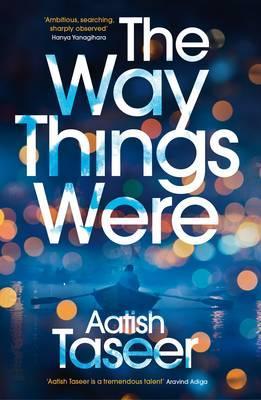
The Way Things Were
Aatish Taseer
Pan Macmillan India 2015
Aatish Taseer takes us on a epic journey through time. He combines certain key historical events that have shaped our nation with the lives of his characters. The other background is Sanskrit, the language that we hold dear as part of our heritage. The title itself is a translation of itihasa: history, or literally, the way things were.
Taseer presents a tale of a modern day king, an elite, who even though is half-foreign, eulogises Sanskrit. He dreams of a time when India returns to its once 'pure state', when all around him his co-elites have moved on; away from the old culture, towards Macaulayism and western capitalism. He even goes on a futile trip to save the Babri demolition.
However, he belongs to an elite class himself, something that Taseer points out was the status of Sanskrit itself; it was a language spoken by the elite (read Brahmins). Through Toby, the king of Kalasuryaketu, and his son to whom he teaches the nuances of the language, one gets to learn about the original meanings of several Sanskrit words.
The tumultuous relationship between Toby and his wife, Uma, and the lavish lifestyles and frivolous pastimes of the families (typified by them playing, quite literally, Trivial Pursuit during a moment of crisis), is juxtaposed against the events of national significance; such as the Emergency, Operation Blue Star, Indira Gandhi's assassination, the anti-Sikh riots, and the Babri demolition.
Taseer simply states the facts of the events through the eyes of his characters who experience their consequences first hand, without taking sides. The conclusion is that it is whimsical to believe that India would ever reach the 'pure state', considering the fact that the views and actions of the right-wing activists is entirely different and a lot less puritanical than what India actually was before the invasions, or even during the Vedic period.
In other words, itihasa - the way things were - was different. This is something that Toby, and through him we, learn in the end.
Taseer plays with the concept of kaala: at once both Time and Death. The story begins with Toby's death and proceeds forwards and backwards through time, until his ashes are immersed in the Taamasa - the 'dark' river that flows through Kalasuryaketu.
The names of the principal characters are derivatives of those of the members of the First Family of the Hindu pantheon. Toby's real name is one of the many names of the Lord of Kaala, Shiva Himself; his wife Uma is of course, Parvathi; and his son Skanda is named after Subramanya. Skanda is even working on the translation of the The Birth (of Subramanya or Karthik).
Overall, a very different take, and a bizarre mix of language, culture, class, relationships and yes, itihasa. Taseer's shimmering use of the English language makes it a worthwhile read, and he is in the same league as some of the other users of Asian origin.
And the added attraction of the copy that I read was that it came with the author's signature:
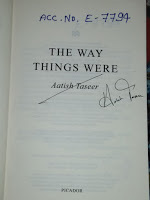
Image source: http://covers.booktopia.com.au/big/97...
Published on July 23, 2016 09:38
July 4, 2016
Talent shows! A comparative observation of British and Indian shows
Coincidentally, Britain's Got Talent and its Indian import, India's Got Talent are being aired at the same time this year.
The former was shown on VH1 (in India), and the latter on Colors TV.
I don't watch any of the usual song and dance reality shows, of which there are dime a dozen on Indian TV channels.
Nor of course, do I ever make the mistake of watching any one of the 'rubber-band' drivel.
But talent shows are different. They showcase real talents, of real people.
And they end in time. Well, certainly BGT does, but IGT gets stretched out a bit.
So here's what I make of these two shows:
Britain's Got Talent

The upside:Short, accurate and crisp. The packaging of the show is just right. It is blessed with witty hosts - Ant and Dec; and a range celebrity judges from different segments of the entertainment industry - acting/singing/production/talent development (not just acting as in IGT). Simon Cowell. Yes, I hear you groaning in protest. But like it or not, it is plain to see. Every contestant waits with bated breath to hear his comments on his/her performance. Cowell says it like it is. And it seems to matter to them, as well as the audience.For comic relief, there is David Williams. Loved him in Little Britain!There are no commercial and promotional interludes during the program. It is focused on the main content, without pandering to the diktats of the commercial industries.
[image error]
The downside:There were too many singing and dancing acts. Yes these are talents too, but isn't there an endless stream of singing/dancing reality shows where these acts can be showcased? Here's a minor grouse: this time, there were quite a few acts that were not from mainland Britain. Some were from other European countries. It is, after all, Britain's Got Talent, isn't it? Then why showcase talents from other countries? Perhaps post-Brexit, we won't see this next year!The entire program is directed towards only one goal in mind: entertaining the Royal Family - the Lords, Masters and yes, Gods of Britain. It is as though the entire event is meaningless without the blessings of one family. Sorry, I find the concept of swearing allegiance to one individual (over and above the nation) appalling. Therefore I do not consider performing in the Royal Variety Show to be the pinnacle of showbiz success.
India's Got Talent
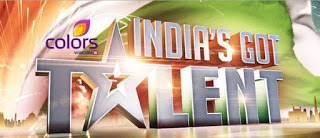
The upside:The talent this year has been especially amazing. Kudos to the team for having reached out to the smaller towns and cities to unearth unseen talents.Just when you think you have seen them all, along comes another act that throws you off your feet; especially the acrobatic and aerial acts.Bharti Singh as the comic relief, is great.Unlike BGT, thankfully, IGT is all about the common man; often even the poor man, who has fought circumstances to present his talent to the entire nation (and not just one family). And I feel that this is telling; it is the desperation to escape from the routine drudgery of their daily lives that brings out the best in these small town folks - this you don't get to see in BGT.

The downside:As with BGT, there are too many singing and dancing acts. There is a rock band this year which has been murdering old Hindi film songs. Unless it is something extraordinary or different from the usual singing/dancing, none of these acts, one hopes, wins. Film promotions: we are cursed with the actors/producers/directors of upcoming releases imposing themselves on reality shows and serials. Just blatant commercialization! Sometimes the entire episode is devoted to promoting the film or serial, and pampering the superstars' egos. Worse, some of these are star-kids, who should not be there in the first place, let alone sit alongside judges! Just hate these promotional interferences!As if that weren't enough, irrational decisions by the judges - all three are from the acting stream, mind - and additional rounds only end up marring the show. For example, the golden buzzer round comprised of participants who had already received that honour from the judges. But in the semifinals, the judges again selected four acts to send through to the finals. One would have thought that audience poll would be in order, considering the judges had already decided once as to who should get the golden buzzer. And sometimes, the judges give a standing ovation for a lackluster act, and remain seated after the ones we think are outstanding. Curious or what! There was at least one act, whose family members were seen distributing pamphlets and canvassing votes from the public. Does this mean that even though the participants have an off day during the semifinals, they should still get the vote from the public? What is this, a political election? This is the downside of public vote; and it appears to be a curious affliction of public voting in Indian reality shows.
So there you have it; my take on BGT and IGT.
For the sake of the common man, woman, boy and girl striving to entertain us and make a name for themselves, perhaps we can overlook the downsides and give them their one chance in the spotlight.
Image sources:
https://metrouk2.files.wordpress.com/...
The former was shown on VH1 (in India), and the latter on Colors TV.
I don't watch any of the usual song and dance reality shows, of which there are dime a dozen on Indian TV channels.
Nor of course, do I ever make the mistake of watching any one of the 'rubber-band' drivel.
But talent shows are different. They showcase real talents, of real people.
And they end in time. Well, certainly BGT does, but IGT gets stretched out a bit.
So here's what I make of these two shows:
Britain's Got Talent

The upside:Short, accurate and crisp. The packaging of the show is just right. It is blessed with witty hosts - Ant and Dec; and a range celebrity judges from different segments of the entertainment industry - acting/singing/production/talent development (not just acting as in IGT). Simon Cowell. Yes, I hear you groaning in protest. But like it or not, it is plain to see. Every contestant waits with bated breath to hear his comments on his/her performance. Cowell says it like it is. And it seems to matter to them, as well as the audience.For comic relief, there is David Williams. Loved him in Little Britain!There are no commercial and promotional interludes during the program. It is focused on the main content, without pandering to the diktats of the commercial industries.
[image error]
The downside:There were too many singing and dancing acts. Yes these are talents too, but isn't there an endless stream of singing/dancing reality shows where these acts can be showcased? Here's a minor grouse: this time, there were quite a few acts that were not from mainland Britain. Some were from other European countries. It is, after all, Britain's Got Talent, isn't it? Then why showcase talents from other countries? Perhaps post-Brexit, we won't see this next year!The entire program is directed towards only one goal in mind: entertaining the Royal Family - the Lords, Masters and yes, Gods of Britain. It is as though the entire event is meaningless without the blessings of one family. Sorry, I find the concept of swearing allegiance to one individual (over and above the nation) appalling. Therefore I do not consider performing in the Royal Variety Show to be the pinnacle of showbiz success.
India's Got Talent

The upside:The talent this year has been especially amazing. Kudos to the team for having reached out to the smaller towns and cities to unearth unseen talents.Just when you think you have seen them all, along comes another act that throws you off your feet; especially the acrobatic and aerial acts.Bharti Singh as the comic relief, is great.Unlike BGT, thankfully, IGT is all about the common man; often even the poor man, who has fought circumstances to present his talent to the entire nation (and not just one family). And I feel that this is telling; it is the desperation to escape from the routine drudgery of their daily lives that brings out the best in these small town folks - this you don't get to see in BGT.

The downside:As with BGT, there are too many singing and dancing acts. There is a rock band this year which has been murdering old Hindi film songs. Unless it is something extraordinary or different from the usual singing/dancing, none of these acts, one hopes, wins. Film promotions: we are cursed with the actors/producers/directors of upcoming releases imposing themselves on reality shows and serials. Just blatant commercialization! Sometimes the entire episode is devoted to promoting the film or serial, and pampering the superstars' egos. Worse, some of these are star-kids, who should not be there in the first place, let alone sit alongside judges! Just hate these promotional interferences!As if that weren't enough, irrational decisions by the judges - all three are from the acting stream, mind - and additional rounds only end up marring the show. For example, the golden buzzer round comprised of participants who had already received that honour from the judges. But in the semifinals, the judges again selected four acts to send through to the finals. One would have thought that audience poll would be in order, considering the judges had already decided once as to who should get the golden buzzer. And sometimes, the judges give a standing ovation for a lackluster act, and remain seated after the ones we think are outstanding. Curious or what! There was at least one act, whose family members were seen distributing pamphlets and canvassing votes from the public. Does this mean that even though the participants have an off day during the semifinals, they should still get the vote from the public? What is this, a political election? This is the downside of public vote; and it appears to be a curious affliction of public voting in Indian reality shows.
So there you have it; my take on BGT and IGT.
For the sake of the common man, woman, boy and girl striving to entertain us and make a name for themselves, perhaps we can overlook the downsides and give them their one chance in the spotlight.
Image sources:
https://metrouk2.files.wordpress.com/...
Published on July 04, 2016 01:47
May 28, 2016
Film review: The Angry Birds Movie

Okay, we all know what this is about. Almost all of us has pulled the slingshot with an angry bird in it to target the pigs and their precarious skyscrapers.
Therefore it is but obvious that one should be curious to find out just what got the birds so fired up.
Why did these flightless birds get their knickers in a twist - in a manner of speaking, because they don't wear any!
What are the green pigs after?
What is the reason for the angry birds to hurl themselves as slingshots at the pigs' empire?
What brings about this transformation from egg-rearing to self-hurling in the inhabitants of the peaceful bird island?
If you - like millions of bird sympathizers - have always been troubled by these birdy existential questions, then you will find your answers in this movie.
I am not going to play spoilsport and reveal the plot fully. Here it is, in an eggshell...err nutshell.
The red, yellow and black birds meet each other - where else, in an anger management class!
Of course they never get over their angry selves, which is just as well, because they are called upon to channelize their anger towards the egg-stealing pigs.
This is also the story of the hero of the franchise - Red, the one with the bushy eyebrows - who evolves from being the most hated bird on the island to the most adored one.
Now about the picturization. It is, overall, very satisfactory.
The birds, pigs, the island, the pigs' ship, and their wobbly castles have all been endearingly recreated, reminiscent of the game itself.
The baby birdies are of course, high on the cuteness factor, and the pigs - who first appear midway through the film - receive whistles from the audience even though they are the villains of the piece.
But the maximum applause is reserved for the slingshot sequence; which is but natural, for that is the reason we have fallen in love with the game version in the first place.
The sequences are shown from both ends of the slingshot - perhaps to enhance the 3-D effect; and even though the birds hit a few castles, we don't get to see the castles crumbling down upon each other as much as we like to.
If only there was a side-on view showing the birds being hurled in a trajectory and the turrets falling down, just as in the game version! That would have had us hurling popcorn at each other in the seats!
That apart, it is fun time throughout.
I asked my daughter what she liked about the movie. Her answer - considering her pillow cover is Angry Birds themed - was unsurprising: 'EVERYTHING!'
Image source: http://www.joblo.com/newsimages1/angr...
Published on May 28, 2016 00:08
March 26, 2016
Article on pain killers
Published on March 26, 2016 09:15
The divine bandits
Banditry is rife in our pilgrimage places.
Apart from the myriad civic problems that your are faced with when visiting a place of pilgrimage, you have to contend with the divine bandits as well. They are everywhere. You have to be at your alert at all times to avoid being conned by one of them.
Let me share a couple of recent experiences so that you know what I mean.
During our recent trip to Rajasthan, we made it a point to visit those twin places of spiritual oneness - Pushkar and Ajmer. One, considered to the holiest of Hindu pilgrimages, and the other, the resting place of the founder of the Chisti order of Sufism. Doesn't get any holier than these in both the cases, does it?
However, our experience in both the place, I am sad to report, was anything but divine or spiritual.
First of all Pushkar:
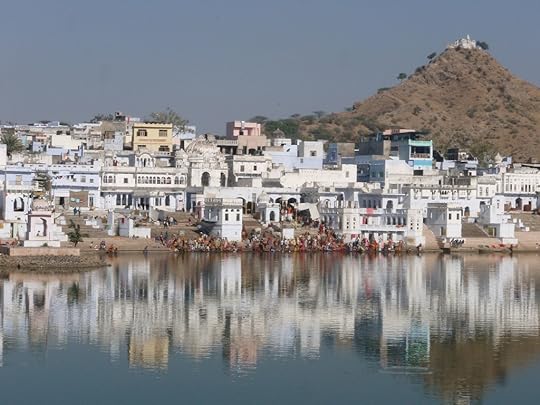
Sadly known more these days for its annual camel fair than the place with the only Brahma temple in the world, Pushkar is a tiny desert place full of temples belonging to all deities and sects . As soon as we arrived there, we were accosted by a host of guides telling us that they could take us through the entire place, and provide us with a full explanation about its significance. One of them was particularly persistent, and said that his charge was only Rs 100 for the entire tour. We agreed, and he first took us to the holy Pushkar lake where he related the story of Brahma and His consorts.
Soon, he introduced us to a priest on the ghats of the lake, who he said would lead us into a prayer. The monetary offering was optional, he said. We relented. The priest arrived and went about reciting the mantras and conducting the jodi ritual - oblations performed by a couple. During the process, we repeated the mantras that he asked us to repeat.
One of the things that was subtly introduced was that we would make a sankalpa to contribute 1, 3, 7 or 21 days' daan for the maintenance of the ghat and the lake, and for feeding the pilgrims. He never said how much it was for each day. Naively I agreed to pay for 7 days. When he escorted us to the billing counter, we realised our folly. The amount per day was Rs 2100! I had just made a sankalpa to cough up Rs 14,700!!! When I protested, he said that one cannot break the sankalpa. Somehow we bargained and got the contribution down to 1 day's worth (Rs 2100).
The bill was made in the name of Shri Tirthguru Pushkar Purohit Sangh, and the transaction looked authentic. So hopefully the money will be utilized for the right purposes. I have no problems in making a daan, but I object to the manner in which the money was extracted from us. Daan should be entirely voluntary. The daani should have full knowledge of what he or she is giving away, and for what purpose. While the latter was told to us, the amount was cleverly hidden away. This, to me, is unacceptable.
Cut to Ajmer. Khwaja Moinuddin Chisti's holy dargah! The Saint who brought Sufism to India!
Naturally, we were filled with excitement and spiritual fervour as the taxi neared the otherwise obscure desert town, only a short drive away from Pushkar.
As soon as we arrived in the tiny parking space that the taxi drivers regularly wait at, we were surrounded by touts who took it upon themselves to conduct us through the tiny, winding roads. One of them got into a tiff with our driver as he heard him advising us to stay away from touts. 'What kind of a driver are you? You are taking away my giraak,' he thundered!
We let the two bicker with each other and started walking up the 1 km long road that leads to the main entrance of the dargah. Actually, crawling would be more appropriate, because there was hardly any space to manoeuvre. The road was teeming with animals, people, vehicles and objects of all shapes and sizes. Touts and beggars accosted us from all angles. Handkerchief sellers stuck their wares under our noses, exhorting us to cover our heads before we entered the dargah. We had to comply with their exhortations.
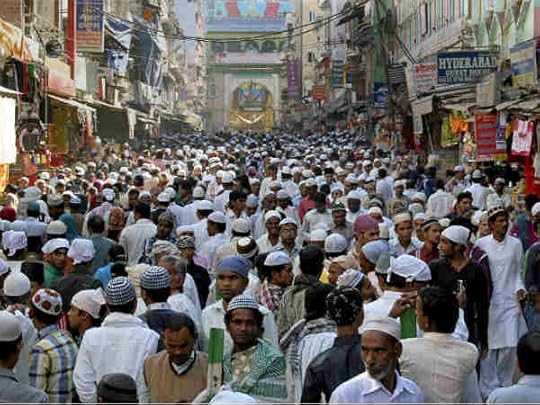
One of the shopkeepers generously asked us to leave our slippers in his shop. When we proceeded to do so, he burst out saying that his shop was not meant only to leave slippers in; one also had to buy the chaddar. Out came our slippers. We somehow managed to leave them in the communal area just outside the entrance to the dargah. One of the beggars who did not receive alms from us suddenly started gesticulating and demanding her share. Another, desperate for attention, was seen rolling away on the road. In one of the by-lanes, a group of children were staring at a large pig with a mixed feeling of awe and disgust.
We were happy to make it into the dargah in one piece. Finally, time for some peace and quiet, we thought. We thought too soon. For no sooner had we entered, than there were further demands for money from the maulvis. One of them was brandishing a peacock feathered broom in one hand and a bowl in another hand. As I was about to enter the sanctum where the mazaar is situated, he whacked me with the broom and asked for money. When I kept walking, he kept hitting me with the broom! I wasn't sure if he was blessing me with the feathered broom, or assaulting me with his weapon.
Inside the mazaar, another maulvi hung out from the railings and asked for more money. There were attention seekers everywhere. It was close to impossible to even look at the mazaar peacefully, let alone stop and offer our prayers. In the end we beat a hasty retreat.
We exited with feelings of despair, disgust and a sense of relief - at having survived the ordeal without any serious damage to life and limb! It is ironic that the Khwaja is called garib nawaz, but the streets leading up to his resting place are filled by just them: garib.
Such is the state of affairs in our so-called holy places. Over-crowded, filthy, chaotic, commercial and filled with money demanding opportunists.
It is high time the authorities of both the places looked into the matter.
Image sources:
https://upload.wikimedia.org/wikipedi...
http://www.oneindia.com/img/2015/09/2...
Apart from the myriad civic problems that your are faced with when visiting a place of pilgrimage, you have to contend with the divine bandits as well. They are everywhere. You have to be at your alert at all times to avoid being conned by one of them.
Let me share a couple of recent experiences so that you know what I mean.
During our recent trip to Rajasthan, we made it a point to visit those twin places of spiritual oneness - Pushkar and Ajmer. One, considered to the holiest of Hindu pilgrimages, and the other, the resting place of the founder of the Chisti order of Sufism. Doesn't get any holier than these in both the cases, does it?
However, our experience in both the place, I am sad to report, was anything but divine or spiritual.
First of all Pushkar:

Sadly known more these days for its annual camel fair than the place with the only Brahma temple in the world, Pushkar is a tiny desert place full of temples belonging to all deities and sects . As soon as we arrived there, we were accosted by a host of guides telling us that they could take us through the entire place, and provide us with a full explanation about its significance. One of them was particularly persistent, and said that his charge was only Rs 100 for the entire tour. We agreed, and he first took us to the holy Pushkar lake where he related the story of Brahma and His consorts.
Soon, he introduced us to a priest on the ghats of the lake, who he said would lead us into a prayer. The monetary offering was optional, he said. We relented. The priest arrived and went about reciting the mantras and conducting the jodi ritual - oblations performed by a couple. During the process, we repeated the mantras that he asked us to repeat.
One of the things that was subtly introduced was that we would make a sankalpa to contribute 1, 3, 7 or 21 days' daan for the maintenance of the ghat and the lake, and for feeding the pilgrims. He never said how much it was for each day. Naively I agreed to pay for 7 days. When he escorted us to the billing counter, we realised our folly. The amount per day was Rs 2100! I had just made a sankalpa to cough up Rs 14,700!!! When I protested, he said that one cannot break the sankalpa. Somehow we bargained and got the contribution down to 1 day's worth (Rs 2100).
The bill was made in the name of Shri Tirthguru Pushkar Purohit Sangh, and the transaction looked authentic. So hopefully the money will be utilized for the right purposes. I have no problems in making a daan, but I object to the manner in which the money was extracted from us. Daan should be entirely voluntary. The daani should have full knowledge of what he or she is giving away, and for what purpose. While the latter was told to us, the amount was cleverly hidden away. This, to me, is unacceptable.
Cut to Ajmer. Khwaja Moinuddin Chisti's holy dargah! The Saint who brought Sufism to India!
Naturally, we were filled with excitement and spiritual fervour as the taxi neared the otherwise obscure desert town, only a short drive away from Pushkar.
As soon as we arrived in the tiny parking space that the taxi drivers regularly wait at, we were surrounded by touts who took it upon themselves to conduct us through the tiny, winding roads. One of them got into a tiff with our driver as he heard him advising us to stay away from touts. 'What kind of a driver are you? You are taking away my giraak,' he thundered!
We let the two bicker with each other and started walking up the 1 km long road that leads to the main entrance of the dargah. Actually, crawling would be more appropriate, because there was hardly any space to manoeuvre. The road was teeming with animals, people, vehicles and objects of all shapes and sizes. Touts and beggars accosted us from all angles. Handkerchief sellers stuck their wares under our noses, exhorting us to cover our heads before we entered the dargah. We had to comply with their exhortations.

One of the shopkeepers generously asked us to leave our slippers in his shop. When we proceeded to do so, he burst out saying that his shop was not meant only to leave slippers in; one also had to buy the chaddar. Out came our slippers. We somehow managed to leave them in the communal area just outside the entrance to the dargah. One of the beggars who did not receive alms from us suddenly started gesticulating and demanding her share. Another, desperate for attention, was seen rolling away on the road. In one of the by-lanes, a group of children were staring at a large pig with a mixed feeling of awe and disgust.
We were happy to make it into the dargah in one piece. Finally, time for some peace and quiet, we thought. We thought too soon. For no sooner had we entered, than there were further demands for money from the maulvis. One of them was brandishing a peacock feathered broom in one hand and a bowl in another hand. As I was about to enter the sanctum where the mazaar is situated, he whacked me with the broom and asked for money. When I kept walking, he kept hitting me with the broom! I wasn't sure if he was blessing me with the feathered broom, or assaulting me with his weapon.
Inside the mazaar, another maulvi hung out from the railings and asked for more money. There were attention seekers everywhere. It was close to impossible to even look at the mazaar peacefully, let alone stop and offer our prayers. In the end we beat a hasty retreat.
We exited with feelings of despair, disgust and a sense of relief - at having survived the ordeal without any serious damage to life and limb! It is ironic that the Khwaja is called garib nawaz, but the streets leading up to his resting place are filled by just them: garib.
Such is the state of affairs in our so-called holy places. Over-crowded, filthy, chaotic, commercial and filled with money demanding opportunists.
It is high time the authorities of both the places looked into the matter.
Image sources:
https://upload.wikimedia.org/wikipedi...
http://www.oneindia.com/img/2015/09/2...
Published on March 26, 2016 07:26
March 7, 2016
Article on the JNU issue
Published on March 07, 2016 21:39



